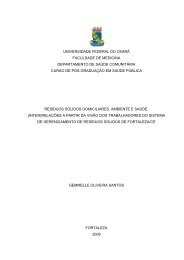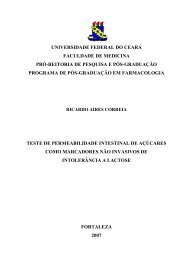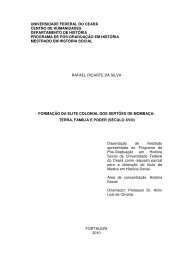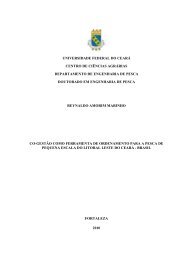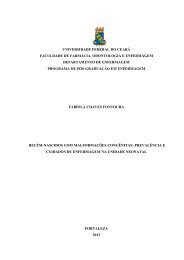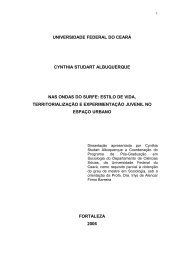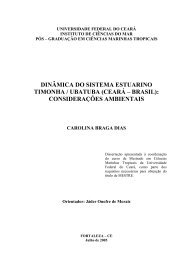Tungíase: doença negligenciada causando patologia grave
Tungíase: doença negligenciada causando patologia grave
Tungíase: doença negligenciada causando patologia grave
Create successful ePaper yourself
Turn your PDF publications into a flip-book with our unique Google optimized e-Paper software.
JAM ACAD DERMATOL<br />
VOLUME 60, NUMBER 3<br />
Table II. Cont’d<br />
area can be considered representative for other<br />
impoverished rural communities in the Brazilian<br />
backlands. Housing is rather poor, income is generally<br />
low, illiteracy is frequent, and social attitudes<br />
and behavior facilitate the transmission of S scabiei.<br />
In Feliz Deserto, scabies was mainly a disease of<br />
children younger than 4 years, who accounted for<br />
almost 30% of all cases diagnosed during the two<br />
surveys. In Brazil, children of this age group usually<br />
wear only diapers, slips, or shorts, independent of<br />
their sex. They have frequent body contacts with<br />
other children during playing and sleeping, and with<br />
older siblings, their mothers, and other women, who<br />
carry around babies and toddlers during the day.<br />
In children aged between 10 and 14 years the<br />
infestation was also very common, with the prevalence<br />
ranging between 9.3% and 16.4%, according to<br />
sex and season. Young age remained a significant<br />
independent risk factor for the presence of scabies<br />
and severe disease in the multivariate regression<br />
analysis. Previous studies in resource-poor settings<br />
also found that children are the most vulnerable<br />
population group. 1,2,4,5,7,9,31<br />
The overall prevalence did not vary between the<br />
surveys, although 102 individuals with scabies were<br />
treated in the first survey. We, therefore, cannot<br />
exclude that without treatment the prevalence would<br />
have been higher in the dry season. However, a clear<br />
seasonal variation has not been detected. This corroborates<br />
findings from other tropical areas, 9,20 but is<br />
in contrast to observations made in industrialized<br />
countries with a cold or moderate climate or developing<br />
countries with a rather cold and dry winter<br />
such as Malawi or Turkey. 4,21,29,43-46 Obviously, in<br />
the hot climate of Northeast Brazil reduced off-host<br />
viability of mites because of high environmental<br />
temperatures does not impede continued<br />
Presence of scabies (n = 151) Presence of severe scabies y (n = 68)<br />
Exposure variable Examined n* Positive n (%) OR (95% CI) P value Positive n (%) OR (95% CI) P value<br />
Sharing towel with others<br />
Yes 532 85 (16.0) 1.60 (1.11-2.32) .01 44 (8.3) 2.03 (1.33-4.09) .001<br />
No 585 62 (10.6) Ref. 22 (3.8) Ref.<br />
Taking shower regularly<br />
No 690 103 (14.9) 1.53 (1.04-2.28) .03 51 (7.4) 2.19 (1.19-4.25) .009<br />
Yes 427 44 (10.3) Ref. 15 (3.5) Ref.<br />
Using soap regularly<br />
No 21 3 (14.3) 1.10 (0.21-3.84) .75 1 (4.8) 0.79 (0.02-5.12) 1.00<br />
Yes 1096 144 (13.1) Ref. 65 (5.9) Ref.<br />
CI, Confidence interval; OR, odds ratio; Ref., reference; WC, water closet.<br />
*Data were not available in all cases.<br />
y Individuals with $ 12 topographic areas affected.<br />
z R$1 US$0.53.<br />
Feldmeier et al 441<br />
transmission throughout the year. 47,48 We suggest<br />
that in impoverished communities in the tropics<br />
reduced off-host viability of mites is compensated<br />
by intense exposure through prolonged and intimate<br />
body contact. In these settings, major parts of the<br />
body are not covered with clothes during day and<br />
night, irrespective of whether it is dry or raining, as<br />
air temperature remains more or less stable. Babies<br />
and small children are carried around on the hip by<br />
their mothers and older girls for several hours during<br />
the day. This should facilitate the transmission of<br />
mites from person to person. 49<br />
The high degree of transmission occurring within<br />
households is best demonstrated by the fact that<br />
individuals who had lived in the community for more<br />
than 6 months had 3.6-fold higher odds for a diagnosis<br />
of scabieseand a 4.2-fold higher odds for the<br />
presence of severe scabieseas compared with individuals<br />
who had recently arrived. In a study in rural<br />
India an almost linear increase in the occurrence of<br />
scabies with increasing household size was observed.<br />
2 However, crowding (defined as [4 individuals/household)<br />
was not associated with the<br />
presence of scabies in this study. This suggests that<br />
the risk of acquiring scabies in the household is not<br />
directly linked to the number of persons living in that<br />
household.<br />
Illiteracy of adult household members was a very<br />
good predictor for the presence of scabies and<br />
severe disease, and remained a significant risk factor<br />
in the multivariate regression analysis (odds ratio 2.8<br />
and 3.2, respectively) (Table III). A low level of<br />
education has been identified as a risk factor for<br />
scabies in developing and industrialized countries.<br />
20,50 Because illiteracy usually goes along with<br />
a low socioeconomic status, the inability to read and<br />
write can be taken as a proxy for poor living



